IDEX Online Research: Jewelry Prices Headed Higher Due to High Supplier Prices in 2010
February 08, 11
(IDEX Online) - Inflation at the jewelry wholesale level raged in 2010, with prices rising by 9.3 percent for the year. Unfortunately, retail jewelry prices rose very little – by only 2.1 percent. This produced a pronounced margin squeeze at the retail level, since retailers were unwilling to push prices higher in the face of an uncertain economy.
IDEX Online Research believes that jewelry retailers will mark their retail prices higher in 2011 due to two factors: 1) an attempt to recover margins, which have eroded due to higher supplier prices, which were not passed along to customers; and 2) much stronger demand for jewelry, especially in the 2010 holiday selling season.
Underlying Components of Jewelry Rose In Price in 2010
The underlying components of inflation rose sharply: gold, silver, platinum and diamond prices were up substantially in 2010. The only piece of good news related to jewelry currencies: they were relatively stable for the year, with only modest swings.
· Precious Metal Costs: Up, Up, Up – In the face of a potentially improving global economy, investors pushed up precious metals prices in anticipation of increased demand to meet the needs of various industries – other than jewelry – which rely heavily on gold, silver and platinum.
· Currencies Stable – While the U.S. dollar lost some value in 2010, it was more stable than most analysts had predicted. With very low interest rates in the U.S., there should be little demand for foreign investment. However, global currency traders apparently think that they would rather own U.S. dollars than some other currencies, so the dollar did not depreciate substantially in value during 2010.
· Demand & Supply Stronger – Normally, prices of goods correlate reasonably closely with demand and supply. Demand for jewelry weakened substantially at the end of 2008 and early 2009, so prices reflected an over-supply of goods and poor demand. However, for most of 2010, jewelry demand was solid, reaching a peak during the all-important holiday selling season. Stronger demand for jewelry will push retail prices higher in 2011.
The table below summarizes the major components of jewelry price inflation for both December 2010 as well as the full year 2010.
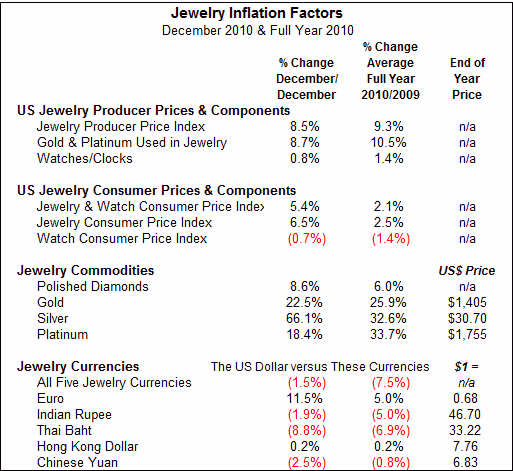
Source: Various markets
December Jewelry Inflation Moderates At Wholesale Level
During December 2010, jewelry price inflation was up by 8.5 percent at the producer level on a year-to-year basis, as measured by the Jewelry Producer Price Index. This was one of the smallest increases during 2010, a period when most months showed double-digit producer price inflation.
Most of the producer price inflation was due to higher commodity costs, including the rising price of gold, silver and platinum.
The following graph illustrates the monthly inflation rate at the jewelry producer level for the past two years. It is clear that inflation is surged at the producer level during virtually all of 2010, with some slight moderation in the final quarter, after remaining relatively calm earlier in 2009.
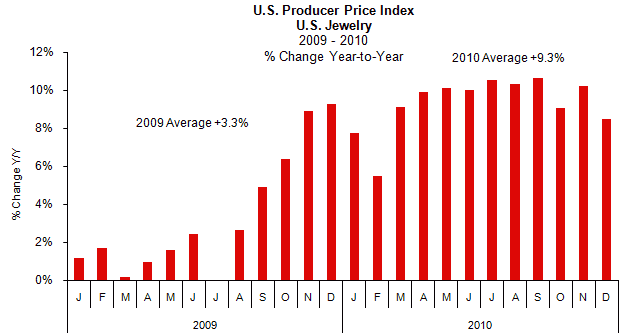
Source: BLS
On an underlying basis, precious metal jewelry – primarily gold merchandise – showed slightly more inflation at the producer level than all jewelry. Total jewelry price inflation at the wholesale level was up 8.5 percent in December; price inflation for gold and platinum jewelry rose by 8.7 percent.
The graph below compares price inflation trends for all jewelry versus precious metal jewelry by month in 2009 and 2010. After being relatively tame earlier in most of 2009, wholesale prices of precious metals jewelry were sharply higher in 2010, peaking in the mid-year period.
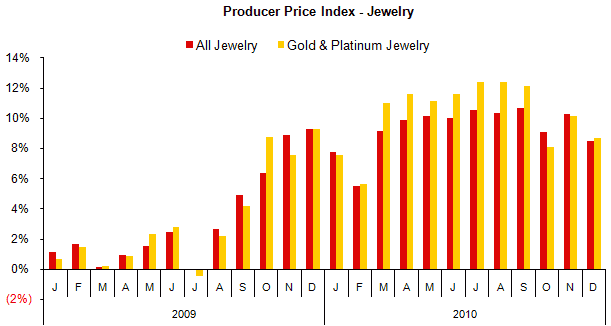
Source: BLS
Watch Price Inflation Moderate At Producer Level in December
One thing is for sure: fine watch prices did not contribute to the sharp rise in jewelry producer price inflation during December. Fine watch prices were up a very modest 0.8 percent at the producer level during the month. This trend will likely change, since many jewelers cited watches as a category with strong demand during the 2010 holiday selling season.
The graph below illustrates month-by-month price inflation trends for fine watches at the producer level during 2009 and 2010.
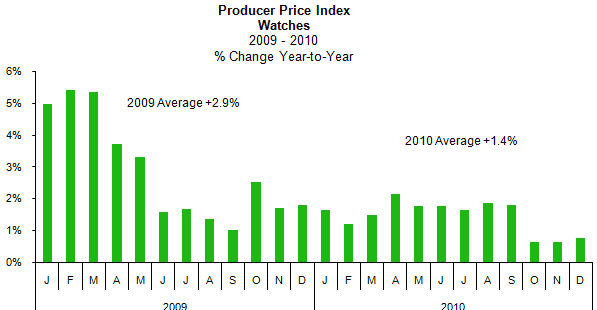
Source: BLS
Producer Price Inflation Soars For Full Year 2010
The annual inflation rate for jewelry at the producer (wholesale) level soared in 2010, and was consistently high during virtually every month.
· Jewelry & Watch Producer Price Inflation (JPPI) +9.3 percent
o Jewelry Producer Price Index +10.5 percent
o Watch Producer Price Index +1.4 percent
Over the past two decades (excluding 2010), the Jewelry Producer Price Inflation rate has averaged about +1.6 percent on an annual basis. Thus, the Jewelry Producer Price Inflation index in 2010 of +9.3 percent dramatically exceeded the average of the past two decades. Further, when compared to the jewelry supplier inflation rate during the past few years, 2010’s inflation rate outpaced every year since the index began in 1982, as the graph below illustrates.
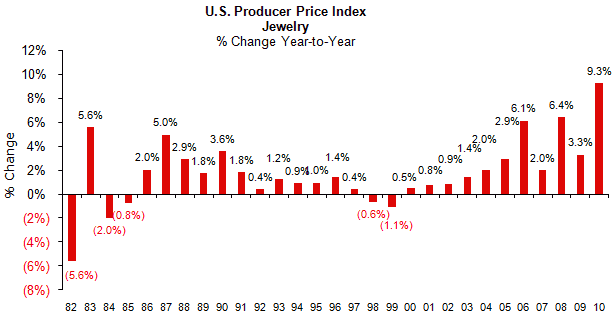
Source: BLS
Jewelry Retail Price Inflation Modest in December
During December 2010, retail prices for jewelry and watches rose by 5.4 percent, reflecting the highest inflation rate of any month during 2009 and 2010.
The graph below illustrates monthly retail jewelry price inflation for the past two years.
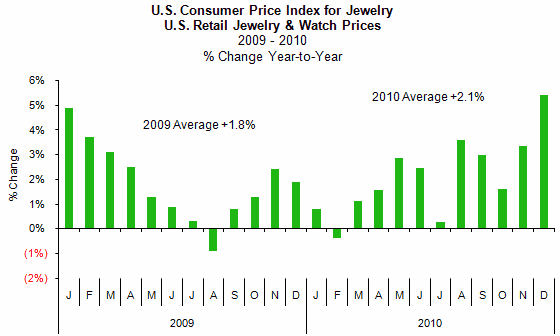
Source: BLS
Underlying Components of JCPI Show Significant Disparity in December
Jewelry prices were up 6.5 percent, while watch prices at retail fell by 0.7 percent during the month, when compared to the same month in 2009.
The decline in fine watch prices is no surprise, since watch prices at the producer level showed little movement. Watches have shown price deflation at the retail level for all but two months during 2010. In contrast, retail prices of jewelry moved higher during every month of 2010, driven largely by higher precious metals prices.
The graph below compares the overall inflation rate for jewelry and watches by month to each of the component inflation rates – jewelry and watches separately.
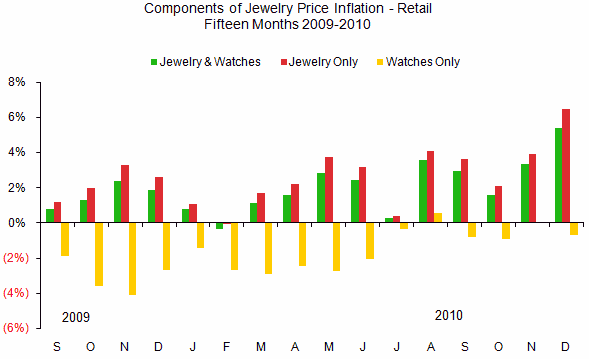
Source: BLS
Annual Retail Jewelry Price Inflation Modest in 2010
In contrast to 2006, 2007, and 2008, retail price inflation for jewelry in 2009 and 2010 showed only a very modest increase. In 2009, retail jewelry prices rose by 1.8 percent, while they rose by 2.1 percent in 2010. Clearly, the recessionary environment had a negative impact on jewelry prices. Retail jewelers were unable to raise prices for fear of turning off already-weak demand for jewelry. Thus, the only winners in the inflation game were the consumers who were able to buy jewelry at prices that probably won’t repeat themselves in the next decade.
The jewelry retail price inflation rate of 2.1 percent during 2010 was modestly above the long-term jewelry retail price inflation rate of 1.6 percent over the past two decades.
At the component level, jewelry prices rose by 2.5 percent in 2010 while fine watch prices declined by 1.4 percent.
The graph below summarizes the annual rate of retail jewelry price inflation in the U.S. market for the past two decades.
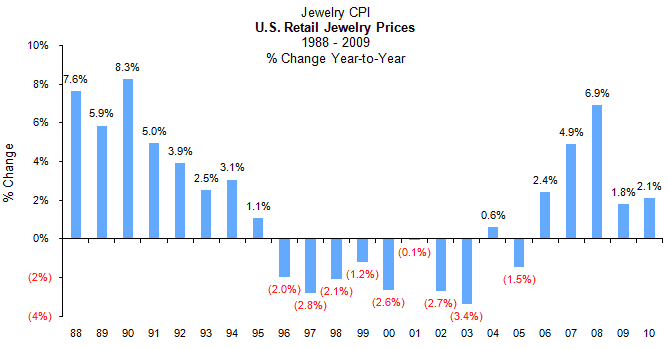
Source: BLS
Jewelry Producer Inflation Rates Outstrip Retail Jewelry Inflation Rates Every Month in 2010
The margin squeeze is real: jewelry producer prices have risen dramatically faster than retail jewelry prices during every month of 2010.
The graph below compares retail jewelry prices and wholesale jewelry prices on a monthly basis during 2010.
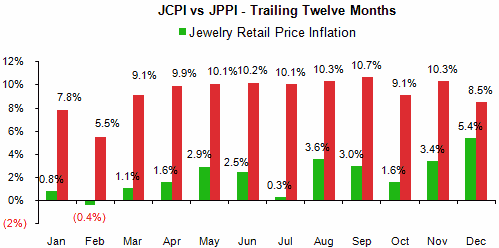
Source: US Dept of Commerce
Annual Jewelry Prices At Wholesale Rise More Than Retail Jewelry Prices for Most of the Decade of the 2000s
Unfortunately, the monthly inflation trends for the jewelry industry during 2010 were reflected in annual trends, not only for 2010 but also for several prior years.
The graph below illustrates the comparison in wholesale jewelry prices versus retail jewelry prices for the past two decades.
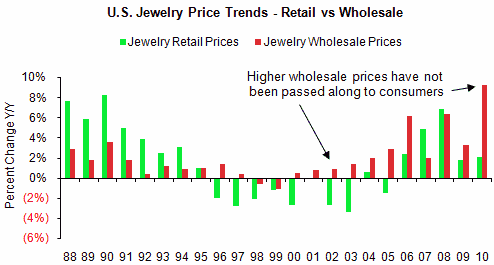
Source: US Dept of Commerce
Outlook: Retail Jewelry Prices Are Headed Higher; Watch Price Inflation Much Less Likely
As the global economy recovers from the recession, demand for many components used in jewelry – primarily precious metals – will increase significantly, not only from jewelry demand, but from demand for other products, which use precious metals in the manufacturing process. As a result, we are already seeing retail prices move up as precious metals prices rise.
The only good news is that the retail prices of lower price-point merchandise probably won’t rise as quickly has more expensive goods. The largest cost component of lower price-point merchandise – under $300 at retail – is labor. Globally, currencies have been stable, and there is some indication that the U.S. dollar may be strengthening.
However, jewelry merchandise priced at $1,000 and above retail is likely to rise more sharply in price since the costs of both the precious metals and precious gemstones are the largest cost component of the goods.
It is difficult to forecast watch prices. Luxury watch buyers finally returned to the market in the final months of 2010. That’s a good sign. However, more consumers have forsaken their watches in favor of checking the time with their mobile phones, computers and other electronic gadgets.